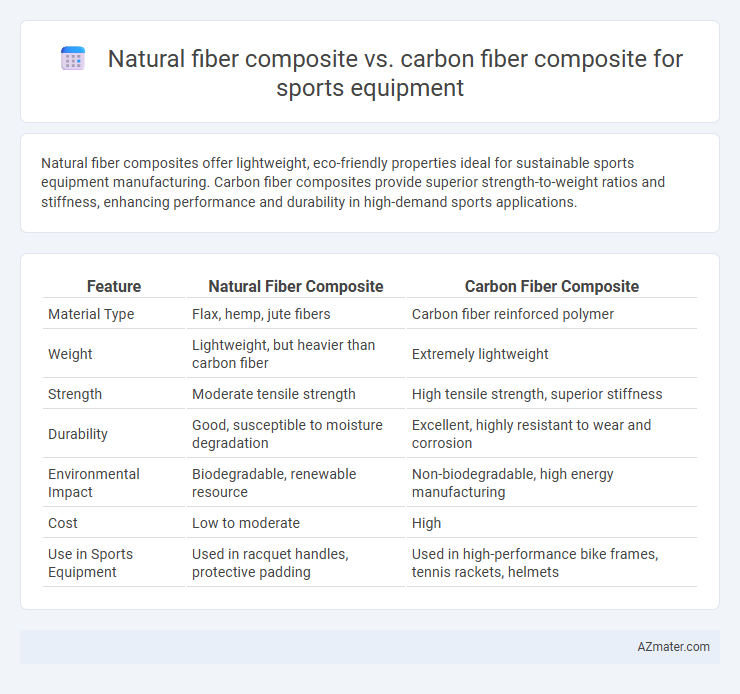Natural fiber composites offer lightweight, eco-friendly properties ideal for sustainable sports equipment manufacturing. Carbon fiber composites provide superior strength-to-weight ratios and stiffness, enhancing performance and durability in high-demand sports applications.
Table of Comparison
| Feature | Natural Fiber Composite | Carbon Fiber Composite |
|---|---|---|
| Material Type | Flax, hemp, jute fibers | Carbon fiber reinforced polymer |
| Weight | Lightweight, but heavier than carbon fiber | Extremely lightweight |
| Strength | Moderate tensile strength | High tensile strength, superior stiffness |
| Durability | Good, susceptible to moisture degradation | Excellent, highly resistant to wear and corrosion |
| Environmental Impact | Biodegradable, renewable resource | Non-biodegradable, high energy manufacturing |
| Cost | Low to moderate | High |
| Use in Sports Equipment | Used in racquet handles, protective padding | Used in high-performance bike frames, tennis rackets, helmets |
Introduction to Composite Materials in Sports Equipment
Natural fiber composites in sports equipment offer lightweight, sustainable alternatives with good impact resistance and vibration damping, making them ideal for eco-conscious athletes. Carbon fiber composites provide superior strength-to-weight ratio, stiffness, and fatigue resistance, enhancing performance in high-demand sports applications like cycling frames, tennis rackets, and golf clubs. Both materials revolutionize sports equipment by combining fibers with polymers to optimize durability, flexibility, and weight, tailored to specific sporting needs.
Overview of Natural Fiber Composites
Natural fiber composites used in sports equipment typically combine fibers such as flax, hemp, or jute with polymer matrices, offering sustainable and lightweight alternatives to traditional materials. These composites provide benefits like improved impact resistance, biodegradability, and reduced environmental footprint compared to carbon fiber composites. Although carbon fiber composites excel in strength and stiffness, natural fiber composites are gaining traction due to their cost-effectiveness and eco-friendly properties.
Overview of Carbon Fiber Composites
Carbon fiber composites are widely used in sports equipment due to their exceptional strength-to-weight ratio, high stiffness, and excellent fatigue resistance, making them ideal for performance-driven applications such as bicycle frames, tennis rackets, and golf clubs. These composites consist of carbon fibers embedded in a polymer matrix, typically epoxy, which provides enhanced durability and rigidity compared to natural fiber composites. Their superior mechanical properties enable sports equipment to achieve greater responsiveness and precision, though the higher cost and environmental impact differentiate them from natural fiber alternatives.
Mechanical Properties: Strength and Flexibility
Natural fiber composites exhibit moderate strength and high flexibility, making them suitable for sports equipment requiring impact absorption and lightweight performance. Carbon fiber composites provide superior tensile strength and stiffness, offering enhanced durability and rigidity essential for high-performance sports gear. The choice depends on the balance between flexibility for comfort and stiffness for optimal mechanical performance in applications such as helmets, rackets, and protective gear.
Weight and Performance Comparison
Natural fiber composites in sports equipment offer a lightweight alternative with densities typically ranging from 1.2 to 1.5 g/cm3, resulting in lower environmental impact but generally lower stiffness and strength compared to carbon fiber composites. Carbon fiber composites, boasting densities around 1.6 g/cm3 and superior tensile strength up to 4000 MPa, deliver exceptional performance and stiffness critical for high-impact sports applications. While natural fibers provide adequate durability for recreational use, carbon fiber composites dominate professional sports equipment due to their optimized weight-to-performance ratio and enhanced fatigue resistance.
Environmental Impact and Sustainability
Natural fiber composites, made from renewable materials such as hemp, flax, or jute, offer a lower carbon footprint and are biodegradable, reducing long-term environmental impact compared to carbon fiber composites. Carbon fiber composites provide superior strength-to-weight ratios but involve energy-intensive manufacturing processes and are challenging to recycle, leading to greater environmental concerns. In sports equipment, natural fiber composites enhance sustainability by using eco-friendly raw materials, while carbon fiber composites require advancements in end-of-life recycling technologies to improve their environmental profile.
Cost Analysis: Production and Material Expenses
Natural fiber composites for sports equipment offer significantly lower material and production costs, as they utilize renewable, widely available fibers like flax or hemp combined with less energy-intensive manufacturing processes. Carbon fiber composites, while providing superior strength-to-weight ratios and performance, incur substantially higher expenses due to costly raw materials and energy-demanding production techniques such as autoclave curing. Evaluating cost analysis reveals natural fiber composites present a budget-friendly alternative suitable for mid-range sports gear, whereas carbon fiber composites remain the premium choice for high-performance applications with higher financial investment.
Applications in Sports Equipment
Natural fiber composites are increasingly used in sports equipment such as tennis rackets, bicycles, and protective gear due to their lightweight, eco-friendly properties, and good vibration damping, enhancing player comfort and reducing environmental impact. Carbon fiber composites dominate high-performance sports applications including racing bicycles, golf clubs, and helmets, offering superior strength-to-weight ratio, stiffness, and durability critical for competitive sports demands. The choice between natural fiber and carbon fiber composites depends on the required balance between sustainability, performance, and cost in various sports equipment manufacturing processes.
Durability and Maintenance Considerations
Natural fiber composites in sports equipment offer moderate durability with benefits of lightweight and eco-friendliness, but they are more susceptible to moisture absorption and degradation, requiring regular maintenance and protective coatings. Carbon fiber composites provide superior durability with high strength-to-weight ratio, exceptional resistance to fatigue, and minimal maintenance needs due to their inherent chemical stability and resistance to environmental factors. Choosing between these materials depends on balancing environmental impact and lifecycle maintenance with performance demands in sports gear.
Future Trends and Innovations in Composite Materials
Natural fiber composites are gaining momentum in sports equipment due to their sustainability, lightweight properties, and enhanced impact resistance, driven by advances in bio-based resins and hybrid fiber technologies. Carbon fiber composites continue to evolve with innovations in nanomaterial integration, improving strength-to-weight ratios and offering superior fatigue resistance for high-performance applications. Future trends emphasize eco-friendly manufacturing processes and recyclability, bridging the gap between environmental impact and elite athletic performance.

Infographic: Natural fiber composite vs Carbon fiber composite for Sports equipment
 azmater.com
azmater.com